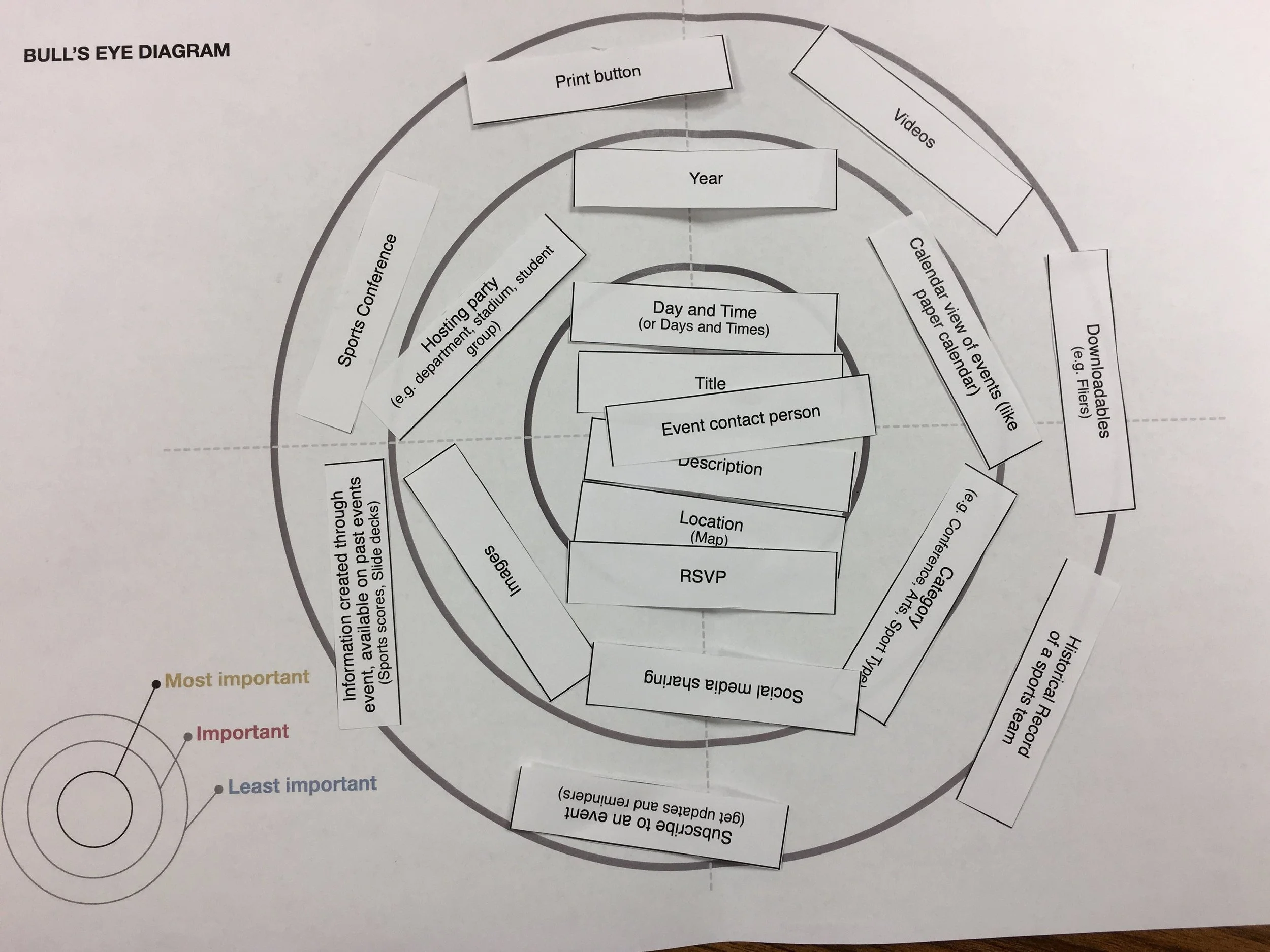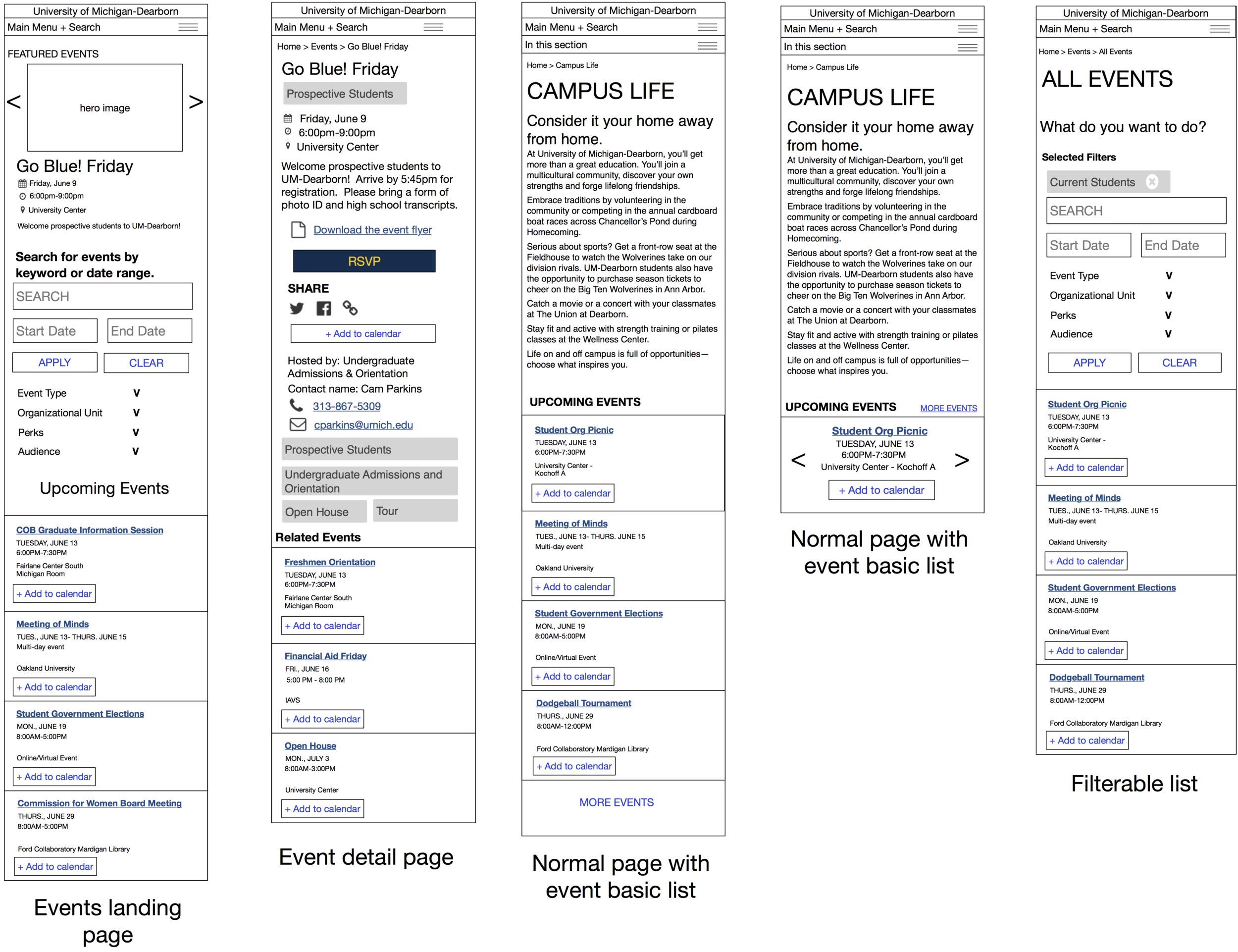Project overview: University events calendar Research AnD DEsign
Methods and Skills: Focus groups, interviews, feature prioritization bullseye exercise, user acceptance testing, wireframing
Deliverables: Research report, wireframes, training documentation for event editors
Tools: Omnigraffle, Google Docs
Who was involved: University stakeholders (people who host and promote events on campus), users (both visitors and event editors), developers, visual designer, technical project manager, web team director, me
Opportunity
Many departments and groups at UM-Dearborn host events and need a way to promote them to prospective and current students, faculty, staff, alumni and community members. Previously, the university maintained a legacy online calendar system that hadn’t been updated in almost a decade. It was lacking a modern design, had a cumbersome editing interface, and was unable to be easily updated. Over time, the number of events being added to it dwindled. The UM-Dearborn web team was tasked with designing a new, more modern calendar that better met user needs on the front and back ends.
Process
Focus Groups
To start, I partnered with the director of the web team to conduct stakeholder focus groups with people across the university who plan and promote a large number of events, including the communications and marketing team, the admissions department, the colleges, library, institutional advancement, and alumni engagement. At these sessions, we broke stakeholders into small groups and asked them to discuss a series of questions, including what is working well about the existing events calendar, what isn’t working well, what they need the calendar to do moving forward, what type of information they’d like to be able to tell users about their events, and who they are promoting events to.
Key insights:
We heard that the calendar was difficult to update, especially due to an approval process that had to take place before an event was posted to the calendar and before any changes to an existing event were made. Oftentimes, users had a hard time tracking down their approvers and event updates weren’t being made in a timely manner. Event approvers also weren’t spending much time at all reviewing events because of time constraints and weren’t adding a lot of overall value to the event editing process.
Everyone we spoke to was dissatisfied with the look-and-feel of the calendar and felt it should be modernized, as it is one of the primary tools for marketing events to both internal and external visitors. Data has shown that prospective students who attend an on-campus event at the university are more likely to enroll in a future semester so it was especially important that event information is easy to find and read and that event webpages are visually appealing to those users.
The search functionality on the calendar did not work well. Events were listed in search results in chronological order, starting with the oldest. This was not helpful since many queries returned events from up to 10 years prior and users are usually searching for upcoming events, not past ones.
The taxonomy for categorizing events wasn’t making them easier to find. Although users could filter by event type, many events were tagged as “other” because the of the lack of appropriate event type taxonomy terms.
Users did like that the university offered an online calendar for promoting events that was easily accessible from the homepage. However, there was much to improve upon (as noted above).
Diagram summarizing focus group findings
User Interviews and bullseye feature prioritization activity
I then interviewed prospective and current students, staff, and alumni to better understand their use of the existing calendar and what they’d like to see in a new calendar. For staff members who had access to update events in the calendar, I asked them to complete a few tasks in the system so I could observe the process of adding and updating events. All participants were also asked to find events based on certain criteria in the system and I made note of their searching and filtering behavior. After the interviews, I asked them to complete a bullseye feature prioritization exercise, in which I presented them with a blank bullseye diagram and asked them to place the features (which were printed out on small sheets of paper) that they felt were most important in a new calendar closest to the center of the bullseye, with less important features closer to the edge of the circle. These features were based on things we had heard were important to stakeholders during the focus groups, features on the existing calendar and features we saw on other higher ed online calendars.
Sample bullseye activity response from one research participant
Key insights:
Most participants were not currently using the calendar very often, if at all. Students felt that there were few events (both of interest to them and just in general) posted to it and staff felt that it was not worth their time to post because they assumed no one was looking at the calendar.
Participants overall thought that the event detail page had the appropriate amount of information about an event. However, we also received several comments that the page was not visually appealing.
All participants mentioned wanting the ability to add an event to their Google calendar (or other personal calendar).
Participants are mostly looking at events on their phones.
Students really wanted to be able to find events that offered free food or other giveaways!
Validating Taxonomy (including Treejack study)
Since we heard feedback from our stakeholders that filtering events by the existing event type taxonomy was difficult because of lack appropriate terms, we decided to develop a set of taxonomy terms to make the filtering functionality as useful as possible for users. I met with the web team director and communications manager to first review the existing list of terms and look for areas of possible unclarity or terms that didn’t align with how events are usually promoted in at a higher education institution. We then looked through the list of past events that had been categorized as “other” and to look for patterns and come up with some new terms that could better describe the types of events being held at UM-Dearborn, often by comparing what event type terms would be used in other universities’ online calendars.
With a proposed list of event type terms in place, I created a Treejack study to test some of our new and existing labels we were least sure about. Questions included:
Under which category would you find an upcoming Jazz show?
Under which category would you expect to find the next university-wide commencement?
Under which category would you expect to find a dodgeball tournament hosted by the alumni group, Graduates of the Last Decade (GOLD)?
Under which category would you expect to find Financial Aid Friday, an event at which prospective undergraduate students can meet 1-on-1 with a financial aid advisor?
Under which category would you expect to find Pre-Med Info Night, an event for prospective students interested in pre-med?
Under which category would you expect to find the Pakistani Students Association Annual BBQ & Cricket Event?
The Treejack study was sent out to students, faculty and staff and asked participants under which event type categories they expected to find a certain event. We wanted to see if our mental models aligned with those of our users.
Key insights:
Multiple event type terms may also be needed for certain events, which should be supported by the system.
Certain events may be easier to find under an event audience tag or department tag than an event type tag. For example, a list of all alumni events or all events held by the Admissions department. In addition to an event type taxonomy, we also decided to allow users to categorize and filter events by audience and organizational unit."
We also included a “Perks” taxonomy to allow users to filter events by those with free food, free stuff or class credit to address our interview finding.
Outcome and Next Steps
After conducting and reporting on the user research, I further participated in the design and development of the calendar in the following ways:
Defined requirements and developed wireframes based on stakeholder and user feedback. I led a collaborative wireframing session with the web team, our visual/graphic designer, and communications manager. We decided on the components we liked best from each set of wireframes and considered which ones best met user needs based on the research findings. I then compiled our designs into a set of low fidelity wireframes, taking a mobile first approach since we found most visitor users were looking at event information on their phones, which our developers used to begin work on the calendar. At the same time, I consulted with our technical project manager and vendor development partners on the development of written technical requirements.
Low fidelity mobile wireframes
Paired with our visual designer to turn the wireframes into high-fidelity, branded mockups. I worked closely with him to ensure that user needs and UX best practices were taken into account as the calendar wireframes were turned into high-fidelity mockups.
Followed an Agile development process and after each sprint was completed, conducted user acceptance testing of the back and front ends. I sent volunteer stakeholder participants a weekly set of tasks and questions for the current iteration of the calendar while it was in development to ensure we were meeting user needs and expectations. I then synthesized the feedback and communicated it to our development team, including assigned priority for any reported issues.
Trained users and launched the new calendar. My team paired with our colleagues in the Communications & Marketing team to train users on not only adding events to the calendar but how use it to effectively to promote their events through appropriate imagery, event descriptions, and social media sharing techniques. View training documentation.
Drafted copy for a webpage on How to Submit an Event to inform our broader user community on changes to submitting events
The new events calendar was launched in Fall 2017. Although we do not have exact numbers for comparison because of poor reporting capabilities of the legacy calendar system, usage and awareness of the calendar has increased significantly. I can also say anecdotally that the web team has gotten an increase in access requests for the calendar as more people have learned about the new system as a tool for event promotion.
We continue to improve calendar features based on user feedback. For example, I proposed new logic for displaying related events on an event page to present users with events more relevant to their interests through the use of taxonomy. We are also tracking the Events landing page through heat mapping and have made improvements based on our findings as to how users are interacting with the page. View heatmap findings.



